Selecting the best leader weight
Thinking anglers are always looking for an edge – a change in tactics that will make them more successful at fishing. Sam Mossman reckons that one of the silver bullets is using lighter leaders.
One aspect common to most line-fishing techniques is the use of a leader (or trace) where the hook or lure is attached. This is a critical part of the equipment you use to catch the fish – the section that the fish sees and comes directly in contact with.
Disregarding fly fishing (where leaders thinner and lighter than the main line are used to pass inspection by suspicious fish), leaders mainly comprise of a heavier or harder section that protects the lighter main line from damage by a fish’s teeth, jaws or body, and from sharp rocks, shells and so on. A heavier leader also facilitates handling a fish at the boat or shore, be it ‘wiring’ a gamefish, lifting a modest fish over the side of a boat, or bringing one through the surf or onto the rocks. Aside from wire used on sharks or toothy tropical critters and the Aramid fibres used in assist-hook rigs on several types of lures, monofilaments (either nylon or fluorocarbon) are the usual leader materials chosen for saltwater fishing.
But if we overdo the leader thickness, are we reducing rather than increasing our chances of catching fish? How much firepower, in terms of leader strength, do we really need?
Picky eaters
There is often a considerable difference between what we think we need and what we really need, which applies to leaders and many other aspects of life. Around 40 years ago, when I first moved to Auckland and started stray-lining for inshore snapper, my standard leader was just a doubled section of my 4kg monofilament mainline, effectively an 8kg trace. Even with such a minimalist approach, catch rates were high, and I don’t recall it ever costing me a fish by being ‘bitten off’.
I have stuck with light leaders like this for inshore snapper ever since, although these days, it is mostly a section of ten-kilo Black Magic Tough Trace nylon knotted to the end of my braid line, regardless of whether I am fishing lures or natural baits.
(As an aside, when many anglers bought into the soft-bait system a few years ago, they also bought into light rods, lines and, importantly, the use of 8-10kg leaders as part of the system. I suspect that a fair amount of the considerable success enjoyed with soft-baits and other types of snapper lures may be partly due to the light leaders, which have low visibility and allow soft-bait tails to move seductively).
This begs the question: do fish learn to avoid heavy leaders? Of course, I don’t think that fish actually reason about these things, but I certainly believe fish can become suspicious of unnatural behaviour in their food, and it seems that the more exposure they have to fishing tackle, the more sophisticated they become.
Compare the behaviour of a kingfish, even a small one, which hangs out at a hard-fished wharf, with its cousin in remote ‘tiger country’. I recall a frustrating session at Northland’s Te Hapua Wharf where a bunch of reasonably hard-fished ‘rat’ kings refused all offerings and would not even take live piper. However, even big adult fish will happily smash baits and lures on some unsophisticated rigs at places like the Ranfurly Banks or the Three Kings.
The level of exposure of the fish to fishing tackle is one thing. Another factor to consider is the mood of the fish. When they are switched on and feeding hard, leader thickness/visibility matters much less. At times like this, ‘any mug can catch them’. But away from peak feeding times, the look and ‘feel’ of the lure/bait presentation becomes much more important. Lighter leaders are less visible and more flexible, giving a more natural presentation, which is more likely to pass inspection.
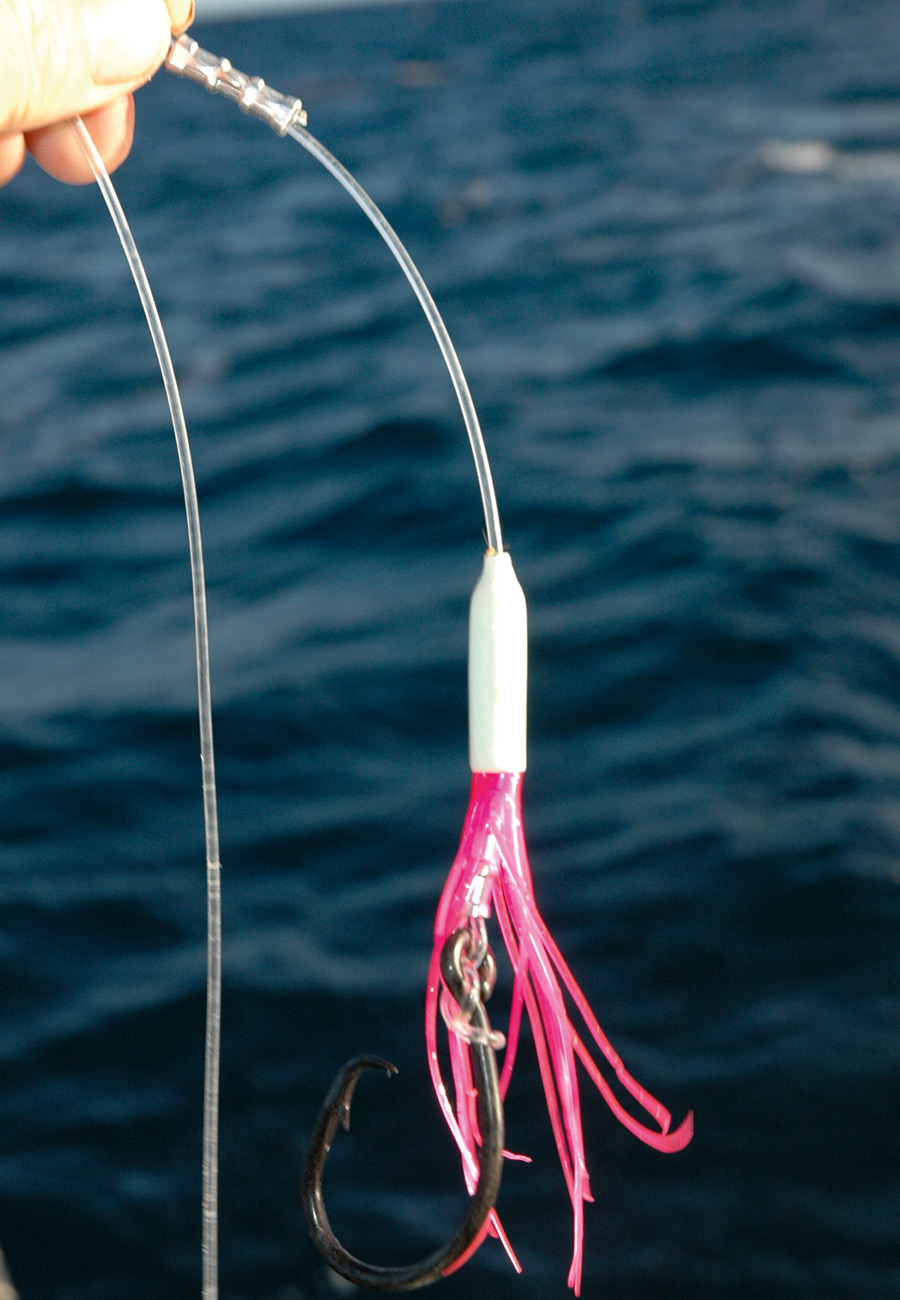
You can get away with seriously heavy leaders in remote, unpressured fisheries, but less obvious tackle can give better results where the fish have seen a fair bit of gear.
Fluorocarbon vs nylon
Talking leader visibility, what about fluorocarbon leaders as opposed to nylon? Fluorocarbon has a refractive index closer to that of water than nylon does, in theory making it more difficult to see underwater. I don’t know – I can see it underwater OK, but I am not a fish! Maybe it is less visible, anyway. I once experimented by trolling two near-identical rigs in Lake Taupo, the only difference between the two being the use of fluorocarbon in one and nylon in the other. The fluorocarbon outfished the nylon by five trout to one.
However, I don’t usually bother with fluorocarbon leaders when soft-baiting, mostly because I find nylon knots better, and my results do not seem to suffer. I can only think of a couple of situations when fluorocarbon made much of a difference. When surface livebaiting for eagle-eyed yellowfin tuna back in the days when they were common, we sometimes had to use 24kg fluorocarbon leaders to get a consistent bite. And years ago, I fished the IGFA International tournament at Cabo San Lucas. In glass-calm conditions, the small (30-40kg) striped marlin were tailing along the surface. They were super-spooky, and we had to go down to 27kg fluorocarbon and mackerel live baits to get consistent bites. Was the key to success the refractive index of the fluoro’ or the fact that it was a fine diameter?
There is a negative side to the properties that fluorocarbon brings to the table, too. We could get away with these light leaders (in gamefish terms) on tuna and small marlin because fluorocarbon is very hard-wearing; however, it is also much stiffer than nylon, affecting presentation. When this material first became available, I rigged a favourite game lure on some 300lb fluoro’ and found that its stiffness killed the lure’s action stone dead; what had been an active, productive lure on nylon was dragging lifelessly like a piece of weed along the surface when rigged on fluoro.
So, while fluorocarbon has advantages in some situations, it can negatively affect others. In most cases, nylon mono is fine; it is cheaper, more flexible (giving better presentations), better for knots, and the visibility aspects can be partly addressed by the reduced diameter of lighter leaders, as we are discussing.
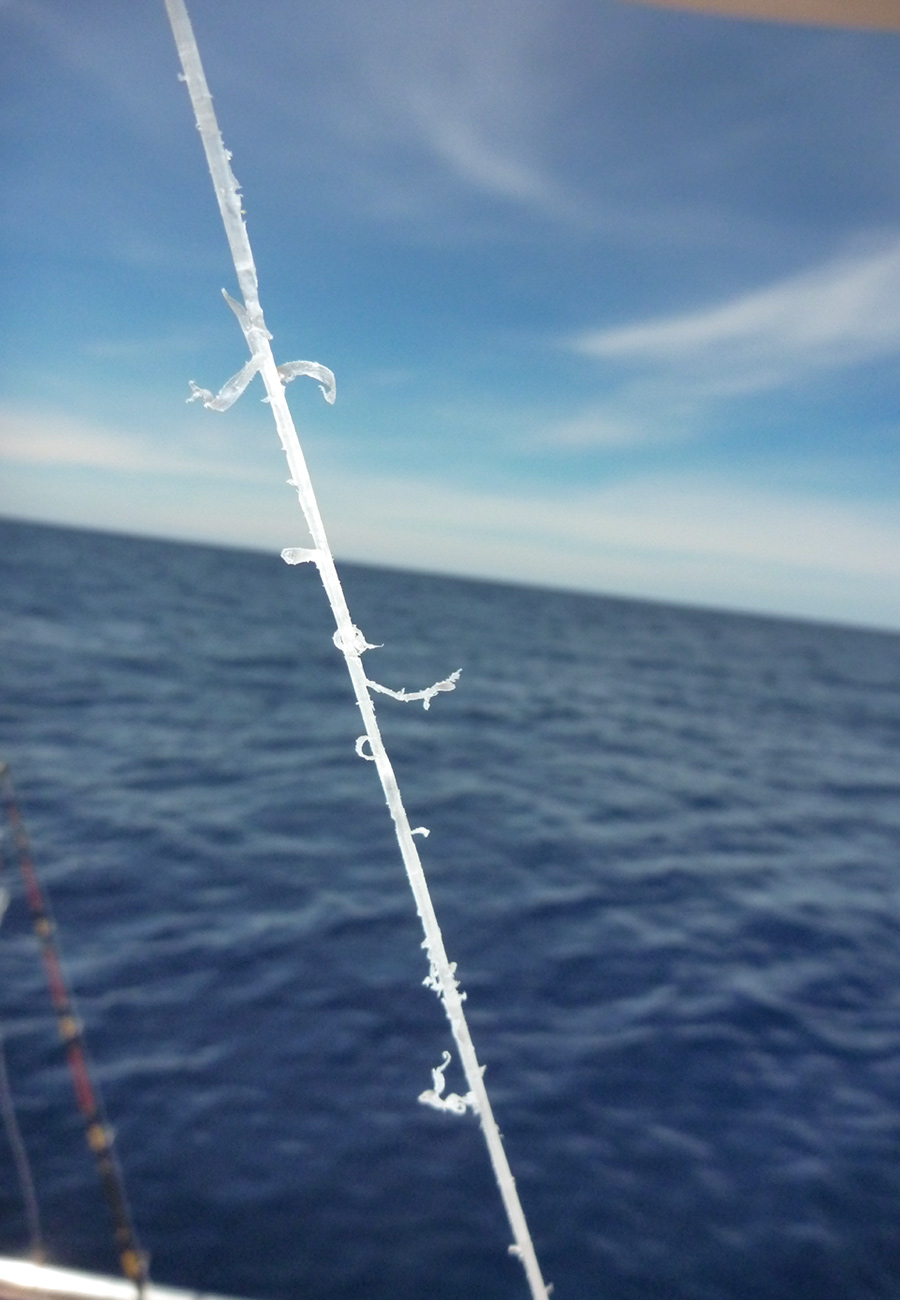
It is amazing what damage a good mono leader can stand up to.
Hooka ‘puka
It is fair to say that lighter traces will usually get more bites in shallow, clear conditions (such as inshore snapper fishing), but in deeper and/or murkier water, there is less light, so you might think that leaders should be less obvious. Certainly, you can often get away with heavier leaders when bottom fishing in deeper water, but experiences over the last few years have convinced me that even in this situation, less can sometimes be more.
Hapuku, bass and bluenose are the classic deepwater fish, and for ‘tiger country’ trips (when there is the chance of double-headers of big fish pulling against each other), I had got into the habit of making heavy, crimp-assembled leaders in 100kg-plus (220lb plus) mono. I caught some pretty good fish on this gear, but on one charter trip, our skipper (now retired), Rick Pollock, reported better success on ‘puka at some of the harder-fished White Island grounds by using smaller hooks and lighter leaders.
I took Rick’s advice to heart, and from then on, depending on where I have been fishing, I have used a compact but strong circle hook rigged on 100lb (45kg) Black Magic Tough Trace, my leader material of choice. This is an ideal size for general deepwater fishing – big enough to take a decent ‘puka, bluenose or bass, but small enough to produce worthwhile species like trumpeter and big tarakihi regularly.
Soon after making the change to lighter deep-water terminal tackle, I got the chance to compare its results against those of crimp-assembled rigs in very heavy mono with circle hooks (and baits) twice the size of mine during trips to the Lachlan and then the Maddon Banks, both in the Hawkes Bay region. The personal limit then was five ‘puka per person.
During the first trip, I quickly caught my limit of five hapuku, then stopped fishing. One other angler, after slow initial results on a heavy leader, changed to a lighter terminal rig with smaller hooks and baits and also caught his five. Three other guys stuck to the heavy terminal rigs and eventually managed two ‘puka each.
On another trip, four of the five first ‘puka caught fell to my 45kg bottom rig. I was a guest on the boat and, not wanting to overdo it, put my ‘puka rod away. Significantly, my fifth ‘puka was caught on an even lighter tarakihi flasher rig. A while later, the bite really came on, and the other four fishermen aboard, using heavy terminal rigs, managed a further eight ‘puka between them, so averaged two each for the day. These two experiences convinced me that lighter bottom rigs can out-produce heavy ones even in deep, dark water.
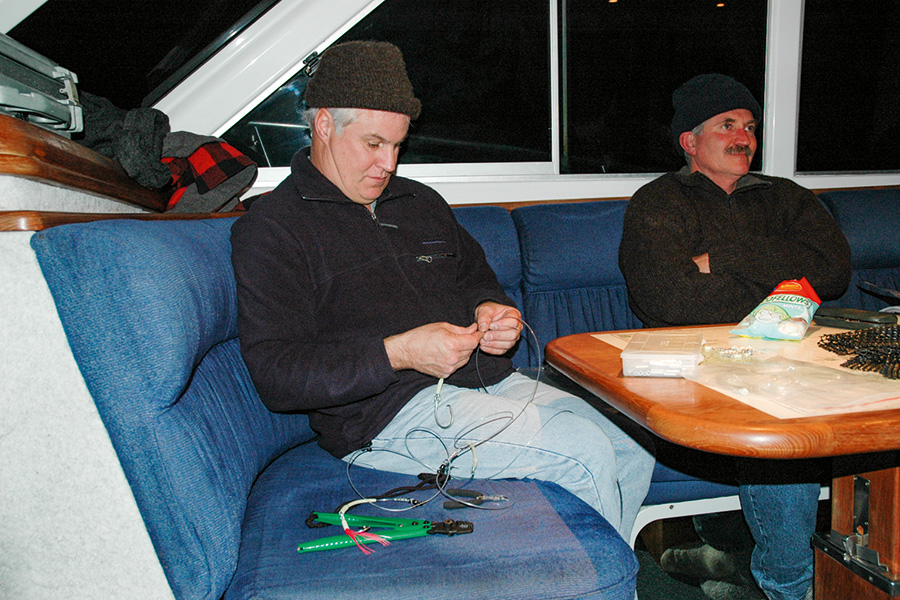
Traditional deep- water leaders were assembled with crimps and 200lb+ mono.
Dealing with the downsides
Going down in leader/hook/bait size to get the bite is one thing, but hooking and handling the fish afterwards can be another. An example is targeting the big trevally that often hang around foul or structures like wharves. They are cover-hunters and can also be very leader shy, but when you drop right down to skinny leaders and main line to get a hook-up, you often don’t have the firepower to control them after you hook them, nor have the abrasion resistance in the leader to survive a brush with a reef or pylon.
Hook setting is another aspect. Big heavy hooks are out of balance with lighter leaders and tackle. They are harder to set into a fish and do not fit well with the concept of lighter, more unobtrusive terminal tackle. However, smaller hooks are much more likely to gut-hook fish – something to be avoided if you want to release them or just for ease of unhooking.
A way to minimise this is to use circle hooks, which are more-or-less self-setting and mainly produce jaw hook-ups. Circle hooks are important for another reason, too; jaw hook-ups mean less wear on your leader material, helping protect it from the fish’s teeth. Lures such as soft-baits, sliders and jigs mostly mouth hook too, and help keep the line away from the fish’s chewing equipment, protecting lighter leaders.
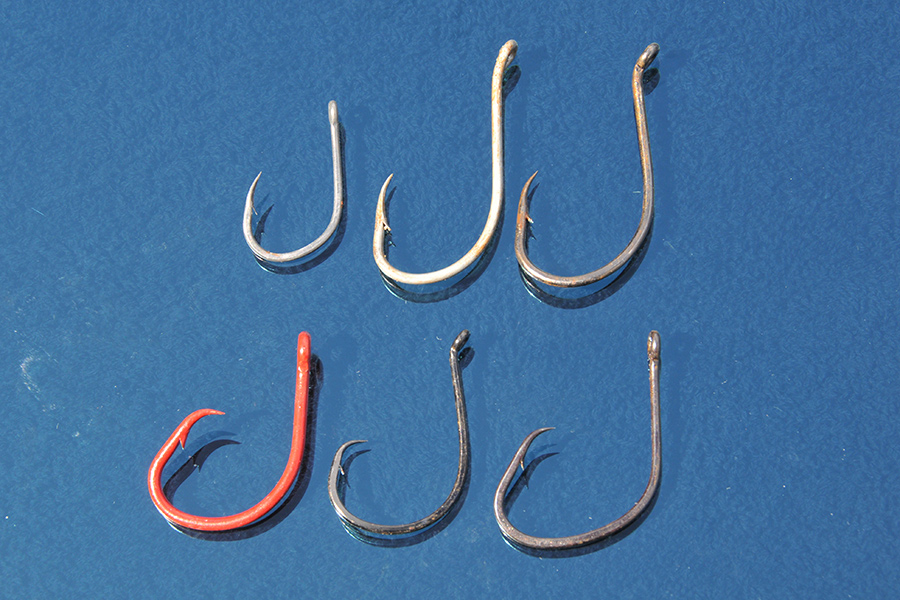
Circle hooks (left) tend to self-set and are a better match with lighter leaders than J or beak hooks (right).
Maximise strength
Another important aspect of using lighter leaders is to maximise their existing strength. Learn to tie the strongest knots to make the most of what you have. There is not space to go into this in-depth here, but an example is the dropper loop. A standard-tie dropper loop tests at about 59% of the unknotted line: you can get away with this poor knot strength because the leader material is often hugely stronger than the main line in the first place and is used for abrasion resistance rather than breaking strength.
But if the leader is closer to the main line in strength (e.g., a 24kg leader on a 15kg line), knot strength can become an issue. Fortunately, there is a much stronger dropper loop knot, invented by the late Paul Barnes, founder of Paul’s Fishing Kites. Paul called it the Kiwi Dropper Loop, and my tests showed it to be 95% of the strength of the unknotted line, a huge advantage over the standard dropper knot. (See how to tie it online at www.fishingkites.co.nz/fishingknots/plat_fishing_knots.html).
Also, watch lighter leaders for damage or wear; they must be up to scratch to cope with bigger fish. Near enough is not good enough. Light leaders may also need replacing more often, so it’s worth pre-tying a few to get back in the game quickly when the bite is on.
So here is an ‘edge’ worth considering – tone down your terminal tackle, particularly your leader material. The fish may take a bit more work to boat, but you may be surprised at the difference this can make to your results. Sometimes, less is more!

November 2022 - Sam Mossman
New Zealand Fishing News Magazine.
Copyright: NZ Fishing Media Ltd.
Re-publishing elsewhere is prohibited
Fishing Reports Visit Reports
Bream Bay Fishing Report - 18/04/24
Change in seasons, change in tactics Not a lot to report in the ‘big fish’... Read More >
Canterbury Fishing Report - 04/04/24
Fish galore! Coming off the back of Easter Weekend and with some very nice weather... Read More >
Raglan Fishing Report - 04/04/24
Excellent snapper action There is some excellent autumn snapper fishing straight out and up the... Read More >
Bream Bay Fishing Report - 04/04/24
Whangarei Harbour fishing well Like the weather, the fishing has been patchy throughout Bream Bay... Read More >
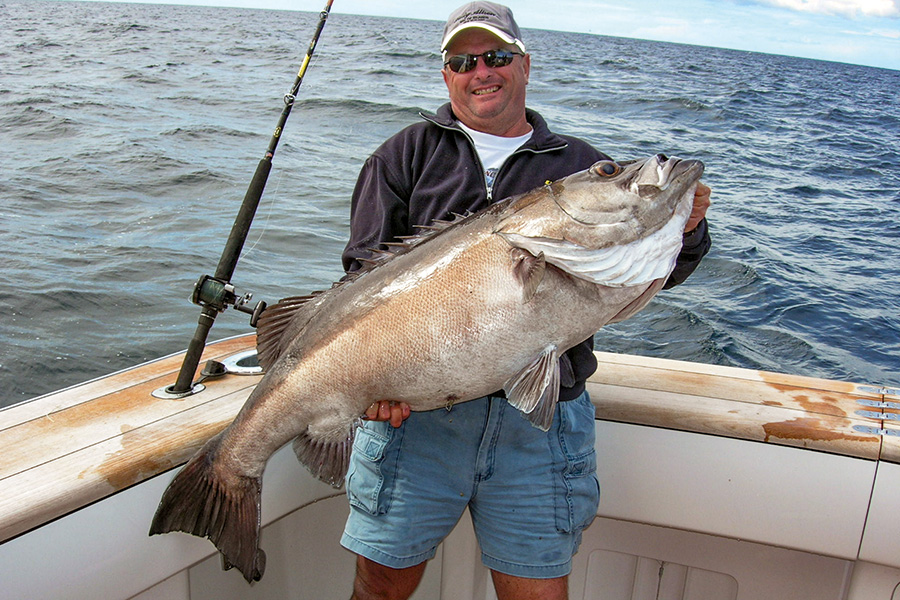



Comments